instrument cluster CHEVROLET KODIAK 2009 User Guide
[x] Cancel search | Manufacturer: CHEVROLET, Model Year: 2009, Model line: KODIAK, Model: CHEVROLET KODIAK 2009Pages: 376, PDF Size: 5.39 MB
Page 156 of 376
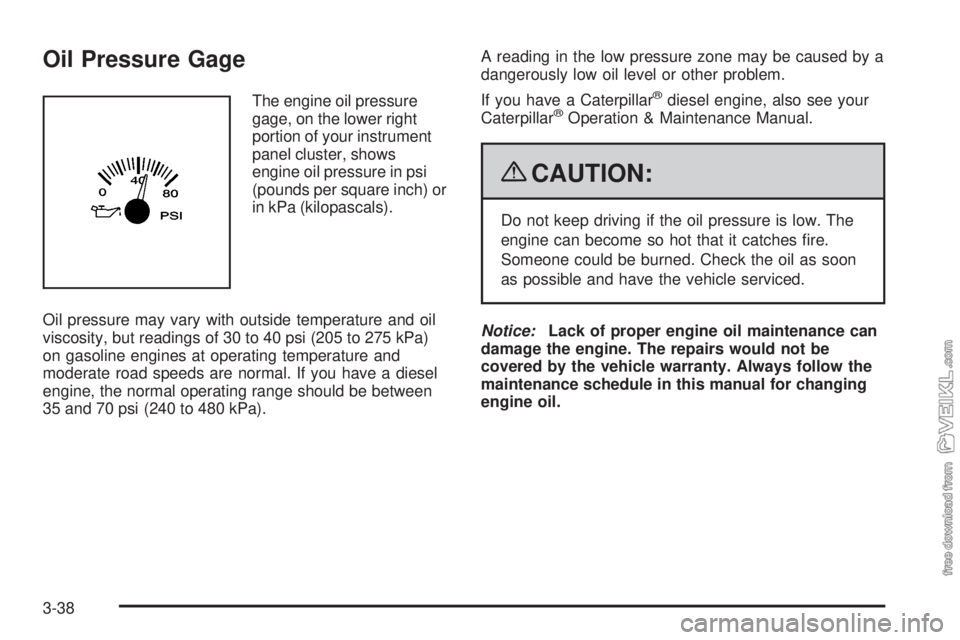
Oil Pressure Gage
The engine oil pressure
gage, on the lower right
portion of your instrument
panel cluster, shows
engine oil pressure in psi
(pounds per square inch) or
in kPa (kilopascals).
Oil pressure may vary with outside temperature and oil
viscosity, but readings of 30 to 40 psi (205 to 275 kPa)
on gasoline engines at operating temperature and
moderate road speeds are normal. If you have a diesel
engine, the normal operating range should be between
35 and 70 psi (240 to 480 kPa).A reading in the low pressure zone may be caused by a
dangerously low oil level or other problem.
If you have a Caterpillar®diesel engine, also see your
Caterpillar®Operation & Maintenance Manual.
{CAUTION:
Do not keep driving if the oil pressure is low. The
engine can become so hot that it catches fire.
Someone could be burned. Check the oil as soon
as possible and have the vehicle serviced.
Notice:Lack of proper engine oil maintenance can
damage the engine. The repairs would not be
covered by the vehicle warranty. Always follow the
maintenance schedule in this manual for changing
engine oil.
3-38
Page 162 of 376
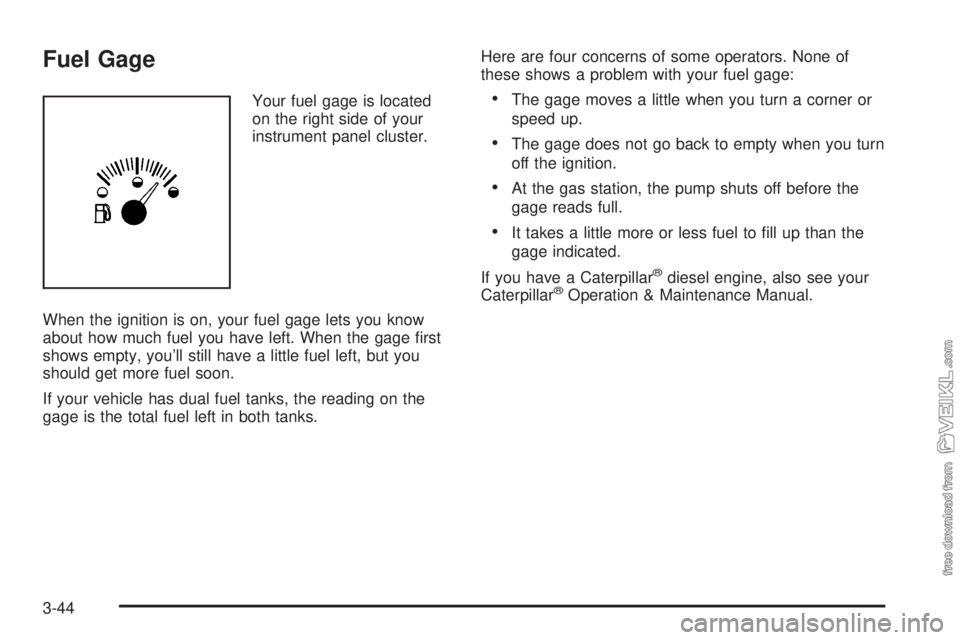
Fuel Gage
Your fuel gage is located
on the right side of your
instrument panel cluster.
When the ignition is on, your fuel gage lets you know
about how much fuel you have left. When the gage first
shows empty, you’ll still have a little fuel left, but you
should get more fuel soon.
If your vehicle has dual fuel tanks, the reading on the
gage is the total fuel left in both tanks.Here are four concerns of some operators. None of
these shows a problem with your fuel gage:•The gage moves a little when you turn a corner or
speed up.
•The gage does not go back to empty when you turn
off the ignition.
•At the gas station, the pump shuts off before the
gage reads full.
•It takes a little more or less fuel to fill up than the
gage indicated.
If you have a Caterpillar
®diesel engine, also see your
Caterpillar®Operation & Maintenance Manual.
3-44
Page 165 of 376
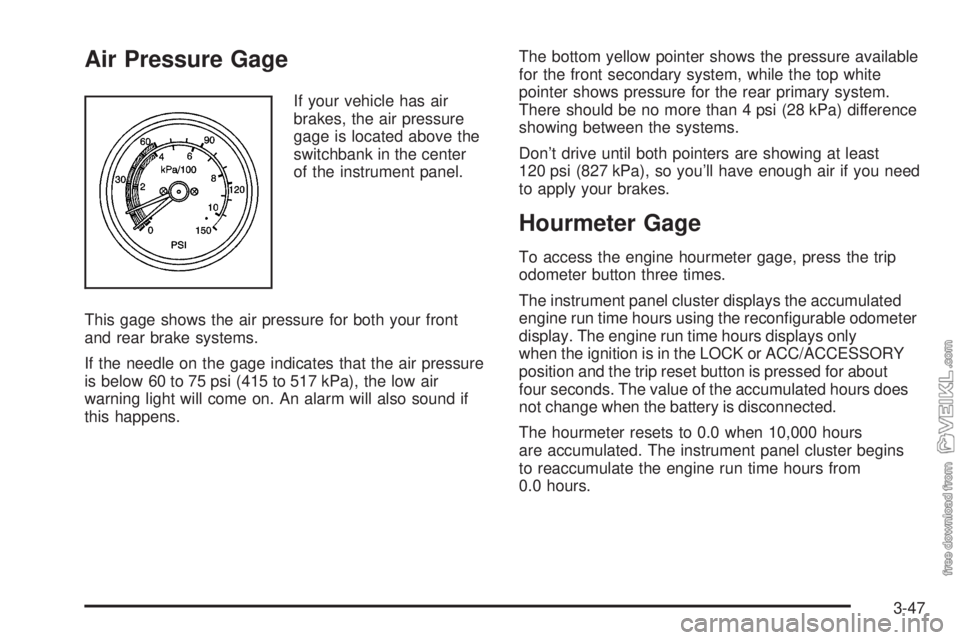
Air Pressure Gage
If your vehicle has air
brakes, the air pressure
gage is located above the
switchbank in the center
of the instrument panel.
This gage shows the air pressure for both your front
and rear brake systems.
If the needle on the gage indicates that the air pressure
is below 60 to 75 psi (415 to 517 kPa), the low air
warning light will come on. An alarm will also sound if
this happens.The bottom yellow pointer shows the pressure available
for the front secondary system, while the top white
pointer shows pressure for the rear primary system.
There should be no more than 4 psi (28 kPa) difference
showing between the systems.
Don’t drive until both pointers are showing at least
120 psi (827 kPa), so you’ll have enough air if you need
to apply your brakes.
Hourmeter Gage
To access the engine hourmeter gage, press the trip
odometer button three times.
The instrument panel cluster displays the accumulated
engine run time hours using the reconfigurable odometer
display. The engine run time hours displays only
when the ignition is in the LOCK or ACC/ACCESSORY
position and the trip reset button is pressed for about
four seconds. The value of the accumulated hours does
not change when the battery is disconnected.
The hourmeter resets to 0.0 when 10,000 hours
are accumulated. The instrument panel cluster begins
to reaccumulate the engine run time hours from
0.0 hours.
3-47
Page 234 of 376
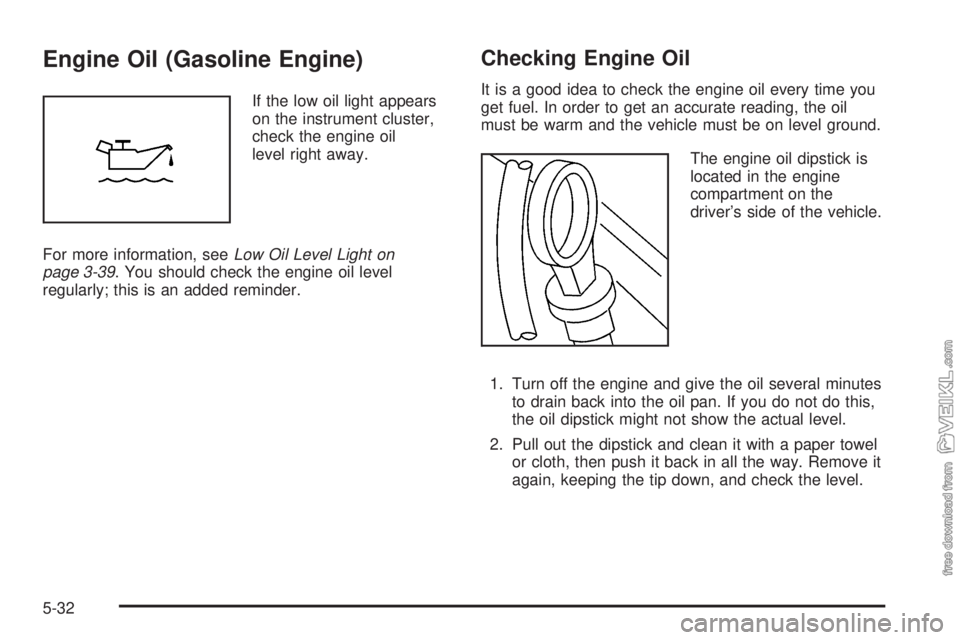
Engine Oil (Gasoline Engine)
If the low oil light appears
on the instrument cluster,
check the engine oil
level right away.
For more information, seeLow Oil Level Light on
page 3-39. You should check the engine oil level
regularly; this is an added reminder.
Checking Engine Oil
It is a good idea to check the engine oil every time you
get fuel. In order to get an accurate reading, the oil
must be warm and the vehicle must be on level ground.
The engine oil dipstick is
located in the engine
compartment on the
driver’s side of the vehicle.
1. Turn off the engine and give the oil several minutes
to drain back into the oil pan. If you do not do this,
the oil dipstick might not show the actual level.
2. Pull out the dipstick and clean it with a paper towel
or cloth, then push it back in all the way. Remove it
again, keeping the tip down, and check the level.
5-32
Page 370 of 376
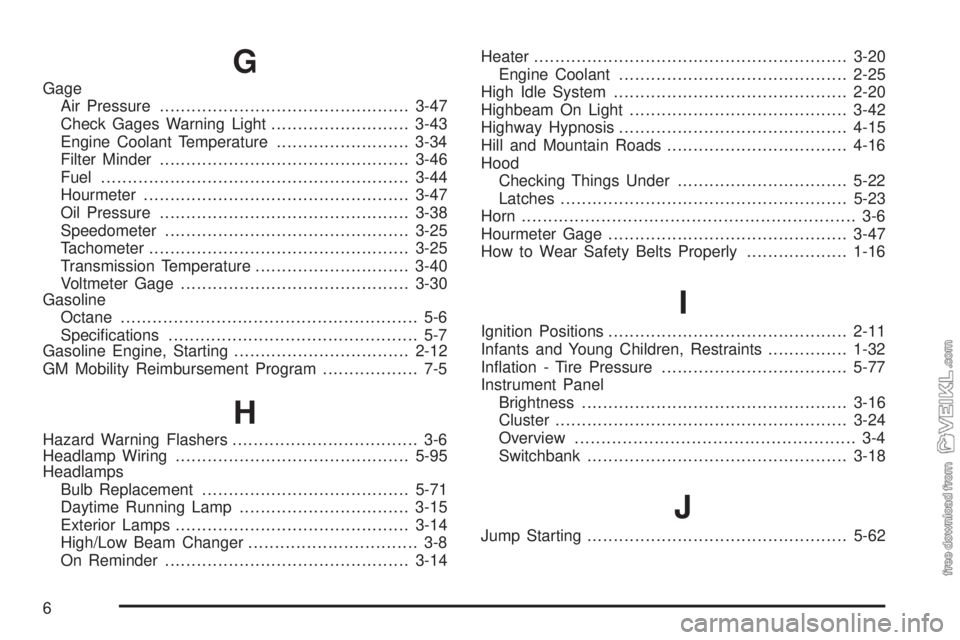
G
Gage
Air Pressure...............................................3-47
Check Gages Warning Light..........................3-43
Engine Coolant Temperature.........................3-34
Filter Minder...............................................3-46
Fuel..........................................................3-44
Hourmeter..................................................3-47
Oil Pressure...............................................3-38
Speedometer..............................................3-25
Tachometer.................................................3-25
Transmission Temperature.............................3-40
Voltmeter Gage...........................................3-30
Gasoline
Octane........................................................ 5-6
Specifications............................................... 5-7
Gasoline Engine, Starting.................................2-12
GM Mobility Reimbursement Program.................. 7-5
H
Hazard Warning Flashers................................... 3-6
Headlamp Wiring............................................5-95
Headlamps
Bulb Replacement.......................................5-71
Daytime Running Lamp................................3-15
Exterior Lamps............................................3-14
High/Low Beam Changer................................ 3-8
On Reminder..............................................3-14Heater...........................................................3-20
Engine Coolant...........................................2-25
High Idle System............................................2-20
Highbeam On Light.........................................3-42
Highway Hypnosis...........................................4-15
Hill and Mountain Roads..................................4-16
Hood
Checking Things Under................................5-22
Latches......................................................5-23
Horn ............................................................... 3-6
Hourmeter Gage.............................................3-47
How to Wear Safety Belts Properly...................1-16
I
Ignition Positions.............................................2-11
Infants and Young Children, Restraints...............1-32
Inflation - Tire Pressure...................................5-77
Instrument Panel
Brightness..................................................3-16
Cluster.......................................................3-24
Overview..................................................... 3-4
Switchbank.................................................3-18
J
Jump Starting.................................................5-62
6